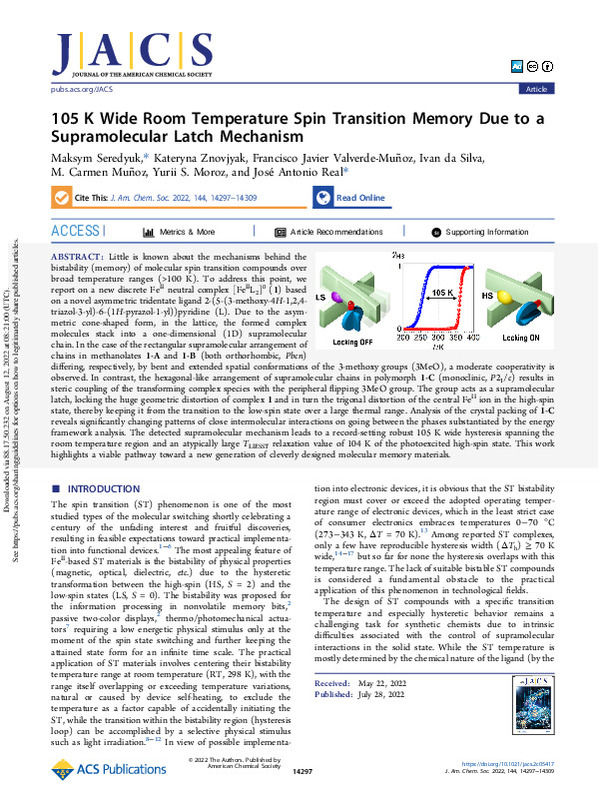JavaScript is disabled for your browser. Some features of this site may not work without it.
Buscar en RiuNet
Listar
Mi cuenta
Estadísticas
Ayuda RiuNet
Admin. UPV
105 K Wide Room Temperature Spin Transition Memory Due to a Supramolecular Latch Mechanism
Mostrar el registro sencillo del ítem
Ficheros en el ítem
| dc.contributor.author | Seredyuk, Maksym
|
es_ES |
| dc.contributor.author | Znovjyak, Kateryna
|
es_ES |
| dc.contributor.author | Valverde-Muñoz, Francisco Javier
|
es_ES |
| dc.contributor.author | da Silva, Ivan
|
es_ES |
| dc.contributor.author | Muñoz Roca, María Del Carmen
|
es_ES |
| dc.contributor.author | Moroz, Yurii S.
|
es_ES |
| dc.contributor.author | Real, José Antonio
|
es_ES |
| dc.date.accessioned | 2023-09-18T18:01:35Z | |
| dc.date.available | 2023-09-18T18:01:35Z | |
| dc.date.issued | 2022-08-10 | es_ES |
| dc.identifier.issn | 0002-7863 | es_ES |
| dc.identifier.uri | http://hdl.handle.net/10251/196705 | |
| dc.description.abstract | [EN] Little is known about the mechanisms behind the bistability (memory) of molecular spin transition compounds over broad temperature ranges (>100 K). To address this point, we report on a new discrete Fe-II neutral complex [(FeL2)-L-II](0) (1) based on a novel asymmetric tridentate ligand 2-(5-(3-methoxy-4H-1,2,4-triazol-3-yl)-6-(1H-pyrazol-1-yl))pyridine (L). Due to the asymmetric cone-shaped form, in the lattice, the formed complex molecules stack into a one-dimensional (1D) supramolecular chain. In the case of the rectangular supramolecular arrangement of chains in methanolates 1-A and 1-B (both orthorhombic, Pbcn) differing, respectively, by bent and extended spatial conformations of the 3-methoxy groups (3MeO), a moderate cooperativity is observed. In contrast, the hexagonal-like arrangement of supramolecular chains in polymorph 1-C (monoclinic, P2(1)/c) results in steric coupling of the transforming complex species with the peripheral flipping 3MeO group. The group acts as a supramolecular latch, locking the huge geometric distortion of complex 1 and in turn the trigonal distortion of the central Fe-II ion in the high-spin state, thereby keeping it from the transition to the low-spin state over a large thermal range. Analysis of the crystal packing of 1-C reveals significantly changing patterns of close intermolecular interactions on going between the phases substantiated by the energy framework analysis. The detected supramolecular mechanism leads to a record-setting robust 105 K wide hysteresis spanning the room temperature region and an atypically large T-LIESST relaxation value of 104 K of the photoexcited high-spin state. This work highlights a viable pathway toward a new generation of cleverly designed molecular memory materials. | es_ES |
| dc.description.sponsorship | This work was supported by the Spanish Ministerio de Ciencia e Innovación (Grant PID2019-106147GB-I00 funded by MCIN/AEI/10.13039/501100011033), Unidad de Excelencia María de Maeztu (CEX2019-000919-M), EU Framework FET-OPEN project COSMICS (grant agreement 766726), and Ministry of Education and Science of Ukraine (Grants 22BF037-03 and 22BF037-04). F.J.V.-M. acknowledges the support of the Generalitat Valenciana (APOSTD/2021/359). The authors are grateful to Miguel Gavara-Edo y Rubén Turo-Cortés for helping us in the Raman and magnetic measurements. | es_ES |
| dc.language | Inglés | es_ES |
| dc.publisher | American Chemical Society | es_ES |
| dc.relation.ispartof | Journal of the American Chemical Society | es_ES |
| dc.rights | Reconocimiento (by) | es_ES |
| dc.subject | Molecular materials | es_ES |
| dc.subject | Magnetic bistability | es_ES |
| dc.subject | Crossover behavior | es_ES |
| dc.subject | Hysteresis loop | es_ES |
| dc.subject | IRON (II) | es_ES |
| dc.subject | State | es_ES |
| dc.subject | Cooperativity | es_ES |
| dc.subject | Complex | es_ES |
| dc.subject | Stacking | es_ES |
| dc.subject | Dynamics | es_ES |
| dc.subject.classification | FISICA APLICADA | es_ES |
| dc.title | 105 K Wide Room Temperature Spin Transition Memory Due to a Supramolecular Latch Mechanism | es_ES |
| dc.type | Artículo | es_ES |
| dc.identifier.doi | 10.1021/jacs.2c05417 | es_ES |
| dc.relation.projectID | info:eu-repo/grantAgreement/AEI/Plan Estatal de Investigación Científica y Técnica y de Innovación 2017-2020/PID2019-106147GB-I00/ES/NUEVOS MATERIALES CONMUTABLES BIESTABLES SPIN-CROSSOVER PARA ELECTRONICA Y ESPINTRONICA MOLECULAR/ | es_ES |
| dc.relation.projectID | info:eu-repo/grantAgreement/GVA//APOSTD%2F2021%2F359/ | es_ES |
| dc.relation.projectID | info:eu-repo/grantAgreement/EC/H2020/766726/EU | es_ES |
| dc.relation.projectID | info:eu-repo/grantAgreement/MESU//22BF037-04/ | es_ES |
| dc.relation.projectID | info:eu-repo/grantAgreement/MESU//22BF037-03/ | es_ES |
| dc.relation.projectID | info:eu-repo/grantAgreement/MICINN//CEX2019-000919-M/ | es_ES |
| dc.rights.accessRights | Abierto | es_ES |
| dc.contributor.affiliation | Universitat Politècnica de València. Escuela Técnica Superior de Ingeniería del Diseño - Escola Tècnica Superior d'Enginyeria del Disseny | es_ES |
| dc.description.bibliographicCitation | Seredyuk, M.; Znovjyak, K.; Valverde-Muñoz, FJ.; Da Silva, I.; Muñoz Roca, MDC.; Moroz, YS.; Real, JA. (2022). 105 K Wide Room Temperature Spin Transition Memory Due to a Supramolecular Latch Mechanism. Journal of the American Chemical Society. 144(31):14297-14309. https://doi.org/10.1021/jacs.2c05417 | es_ES |
| dc.description.accrualMethod | S | es_ES |
| dc.relation.publisherversion | https://doi.org/10.1021/jacs.2c05417 | es_ES |
| dc.description.upvformatpinicio | 14297 | es_ES |
| dc.description.upvformatpfin | 14309 | es_ES |
| dc.type.version | info:eu-repo/semantics/publishedVersion | es_ES |
| dc.description.volume | 144 | es_ES |
| dc.description.issue | 31 | es_ES |
| dc.identifier.pmid | 35900921 | es_ES |
| dc.identifier.pmcid | PMC9380689 | es_ES |
| dc.relation.pasarela | S\470297 | es_ES |
| dc.contributor.funder | Unión Europea | es_ES |
| dc.contributor.funder | Generalitat Valenciana | es_ES |
| dc.contributor.funder | Universitat de València | es_ES |
| dc.contributor.funder | Ministerio de Ciencia e Innovación | es_ES |
| dc.contributor.funder | Ministry of Education and Science of Ukraine | es_ES |








